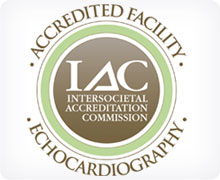Echocardiogram
What is an echocardiogram?
 An echocardiogram, or “echo,” is an ultrasound of the heart. It is one of the most common tests we do. It gives us many useful details about the heart and blood vessels.
An echocardiogram, or “echo,” is an ultrasound of the heart. It is one of the most common tests we do. It gives us many useful details about the heart and blood vessels.
Why is an echocardiogram done?
A cardiologist uses an echocardiogram to see how the heart is working, to look for structural heart problems and to check blood flow within the heart and blood vessels.
How does an echocardiogram work?
It uses sound waves to make a moving 2-dimensional picture of the heart that shows up on a screen. The picture shows the shape and movement of the heart valves, as well as the size of the heart chambers and how they are working.
What happens during a standard echocardiogram?
This is a noninvasive, harmless and painless test, just like an ultrasound for a pregnant person. You and your child will go into a darkened exam room, where your child can lie down on a regular bed.
A sonographer with special training in how to work with babies and children will apply warm ultrasound gel to your child’s chest and heart area. The sonographer will place a small probe in contact with the gel and will move the probe to get images from several viewpoints.
Your child will not feel the sound waves.
We record the echocardiogram digitally so the doctor can review it and compare it to echocardiograms your child has in the future.
It’s important to keep your child quiet and still for the test. We provide entertaining videos to help your child feel calm and comfortable. Younger children may be fed a bottle. If it’s too hard for your child to relax for the echocardiogram, we may need to schedule them for a sedated echocardiogram, where we give them a mild sedative (medicine) before the test.
What is a transesophageal echocardiogram?
Sometimes a standard echocardiogram doesn’t provide all the pictures we need. Your child’s doctor may recommend a test to take pictures from inside the tube that carries food from the throat to the stomach (esophagus). This is called a transesophageal echocardiogram (TEE). Your child will have general anesthesia for a TEE.
In the TEE, we use a narrow tube with an echocardiogram probe on the end of it. We pass this tube down your child’s throat and into their esophagus. The esophagus is right behind the heart, so this method can give us very clear views of the heart’s structure and function.
What is a fetal echocardiogram?
A fetal echocardiogram allows us to check the heart of a fetus in the womb. It is done in the same way as a routine ultrasound during pregnancy. The parent lies flat, we apply warm ultrasound gel to their abdomen and we place a small probe in contact with the gel.
What is a stress echocardiogram?
A stress echocardiogram is a test done when the heart is at rest and again just after the heart has worked hard. It is a type of exercise test and can be a good way to check for blockage or other problems with the arteries that carry blood to the heart muscle (coronary arteries).
In this test, we ask your child to run on a treadmill or pedal a stationary bike. The exercise raises their heart rate and the amount of blood and oxygen the heart muscle needs.
If your child is too young or not able to use a treadmill or stationary bike, the doctor may give your child a medicine called dobutamine to increase their heart rate.
How long does an echocardiogram take?
A standard or fetal echocardiogram usually takes about 30 to 60 minutes. A TEE takes about 20 minutes. A stress echocardiogram usually takes 60 to 90 minutes.
When will we get the results of the echocardiogram?
If your child’s echocardiogram is done as part of a clinic visit, we will give the results to you during that visit. Otherwise, results take 48 to 72 hours. We will fax them to the provider who asked for the test.
Contact Us
Contact the Heart Center at 206-987-2515 for a referral, a second opinion or more information.
Providers, see how to refer a patient.
Paying for Care
Learn more about your echocardiogram bill (PDF) and about paying for care at Seattle Children’s, including insurance coverage, billing and financial assistance.